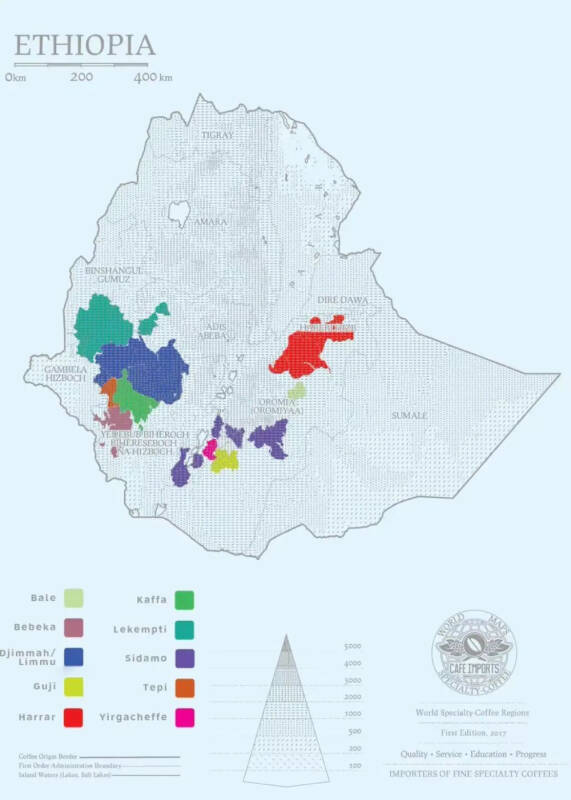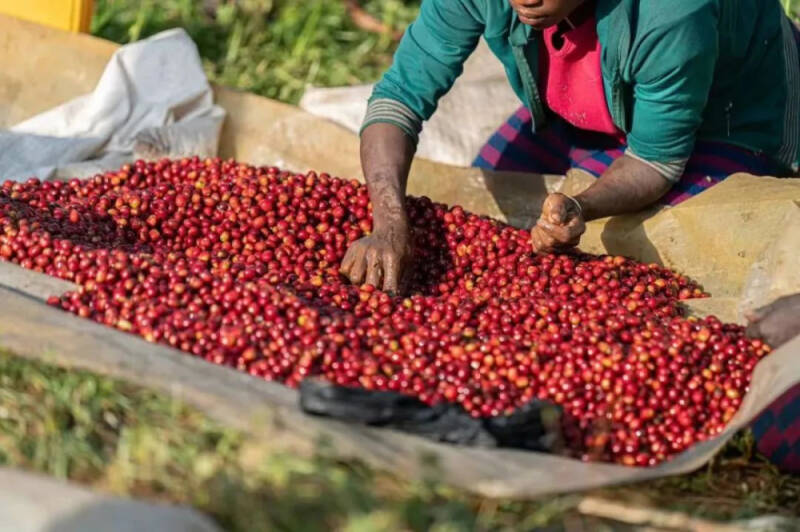What is the "Red Cherry Project" in Ethiopian coffee?
Ethiopia is the largest coffee producer in Africa, has a long history of coffee cultivation, is recognized as the birthplace of coffee, and has countless native varieties of coffee. According to statistics, there are 10000 to 15000 varieties of coffee in Ethiopia today. The coffee produced in this country is loved by many coffee lovers for its fruity flavor and floral flavor.

At present, there are many well-known coffee producing areas in Ethiopia, such as Sidamo, Yirgacheffe, Kaffa and Guji. Yejasuefei is a small town in West Dama (formerly a southern nation state, which was established independently in 2019). It is part of the Sidamo coffee producing area, but it has become a new coffee producing area because of the unique flavor of its coffee.
At present, on Qianjie Street, there are many kinds of coffee beans from Yejasuefi producing area, among which are "Yejiaxuefei Red Cherry" coffee beans. What does this "red cherry" mean? Is it because it tastes like a red cherry?
Actually, it's not. "Red Cherry" here means that this coffee bean comes from a "Red Cherry Project" (Operation Cherry Red) coffee bean. The plan is a project aimed at the quality of farmers.
For a long time, farmers planted coffee trees in their own backyard or farmland. During the picking season, farmers collected coffee fruits and then transported them to raw bean merchants or processing plants. But at that time, the price of coffee was not high, and farmers did not care about the quality of coffee in order to earn more money. No matter whether the fruit was ripe or not, it was harvested at harvest to increase the yield and gain benefits through large quantities. But the effect of this is that the coffee fruit is good and bad, uneven, affecting the final coffee flavor.
In 2007, the arrival of Trabocca, the largest coffee and bean manufacturer in the Netherlands, changed that. The company has been committed to finding all kinds of high-quality raw materials, paying attention to environmental protection and paying attention to the lives of farmers. Therefore, I think that the current form is not conducive to development, so I put forward the "Red Cherry Plan".
To this end, the company will invite all farms in Ethiopia to produce coffee beans in batches of 1500-3000 kg for their wives during the harvest season, but these batches need to meet the requirements of the Red Cherry Project and harvest coffee beans by hand. And 100% pick all red fruit. The company then buys the beans at a price several times higher than the market.

In this way, both farmers and raw bean merchants can make a profit, the income of farmers will be improved, and the quality of raw coffee beans will be guaranteed, and the price will rise accordingly. The small batches required by Trabocca will also give the processing plant enough time and energy to process the coffee fruits.
However, Trabocca will not buy all small batches of coffee beans, even if it meets the basic requirements of the Red Cherry program. After receiving the coffee beans, Trabocca will conduct two cup tests on the coffee in the cup test rooms in Ethiopia and the Netherlands, only if the cup test standard is met. In addition, Trabocca will invest in processing plants, increase equipment, provide financial loan support and impart knowledge to farmers, improve production and provide better quality coffee beans.
At present, the red cherry program includes washing, sun-drying beans, half-washing, half-sun, experimental coffee, and so on. The main producing areas of the plan are Yega Snow, Sidamo, Penga Forest, Lekanti and other producing areas, all of which are producing areas with unique Ethiopian flavor.
To put it simply, Red Cherry plans to increase the purchase price of high-quality coffee raw beans to encourage farmers to complete every process of collecting and processing coffee berries, so that the coffee beans produced are of better quality and taste, and are recognized by the market at the same time. Get a relatively high purchase price.
The red cherry coffee beans on Qianjie Street are from the Yega Sheffield area, using sun treatment, light baking, slightly fermented fruit after cooking, fresh lemon acidity, berry and strawberry flavor, and refreshing taste.
For more information about coffee producing areas, please scan the code directly and follow: coffee comments.
Long press the QR code to follow:
Important Notice :
前街咖啡 FrontStreet Coffee has moved to new addredd:
FrontStreet Coffee Address: 315,Donghua East Road,GuangZhou
Tel:020 38364473
- Prev

Sudden floods in São Paulo State, Brazil! Coffee season is in distress
According to Brazilian media reports, several southern Brazilian states have been hit by storms and thunderstorms in recent days, the most serious of which are São Paulo and Rio de Janeiro states. This storm has caused many casualties, traffic chaos and serious damage to these areas. According to statistics, a total of three people have disappeared and eight have died. according to
- Next

It's sparse! Xi tea and matcha new product "Light Soup and Little Water"?!
▲ Click to pay attention| Daily Boutique Coffee Culture Magazine Coffee Workshop Yesterday, Xicha updated the menu of its Matcha series and launched a new product with triple thickness. According to official propaganda, in addition to matcha tea soup, this new cup also contains small ingredients such as thick cheese milk lid, matcha jelly, thick glutinous rice etc.
Related
- What effect does Italian American coffee with filter paper have? Will coffee taste better if it is put on filter paper at the bottom of the powder bowl?
- What is the color difference in coffee beans? What are the characteristics of honey processed coffee beans? Why are the anaerobically treated coffee beans uneven in color?
- How does novice Xiaobai quickly get started and make coffee? Newbies learn to make coffee by hand and share the specific steps and process process!
- Costa tea has a shelf life of 100 years?! Expert: Unable to verify
- It's a huge uproar! American milk addition was rejected by Manner employees?!
- Mocha pot coffee bean recommendations| How fine and how much powder should be used for grinding? What parameter ratios do I need to use to make milk with Mocha pot coffee?
- What are the characteristics of the world's top ten coffee beans treated with Costa Rica honey? How to make black honey kadura from Tarazhu Pilon Processing Plant taste good?
- How to make deep-roasted coffee? What grinding water temperature does authentic Jamaica Blue Mountain No. 1 coffee use to brew it well?
- Selected high-grade rose summer coffee flavor tasting guide Why Panama rose summer has the aroma of flowers and fruits
- What equipment does a novice Xiaobai need to buy to learn to make coffee? Filter cup electronic scale bean grinder manual flushing pot purchase guide

